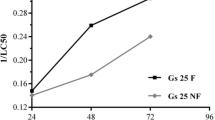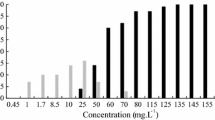Abstract
The acute toxicities of eight commercial herbicides and two surfactants to early fourth instar larvae of the midgeChironomus riparius were determined under static conditions. The formulated herbicides tested were Eradicane® (EPTC), Fargo® (triallate), Lasso® (alachlor), ME4 Brominal® (bromoxynil), Ramrod® (propachlor), Rodeo® (glyphosate), Sencor® (metribuzin), and Sutan (+)® (butylate); the two surfactants were Activator N.F.® and Ortho X-77®. In addition, technical grade alachlor, metribuzin, propachlor, and triallate were tested for comparison with the formulated herbicides. The relative toxicity of the commercial formulations, based on percent active ingredient, varied considerably. The EC50 values ranged from 1.23 mg/L for Fargo® to 5,600 mg/L for Rodeo®. Fargo®, ME4 Brominal®, and Ramrod® were moderately toxic to midge larvae; Lasso®, Sutan (+)®, and Eradicane® were slightly toxic; and Sencor® and Rodeo® were practically non-toxic. The 48-hr EC50 values of the two surfactants were nearly identical and were considered moderately toxic to midges. For two of the herbicides in which the technical grade material was tested, the inert ingredients in the formulations had a significant effect on the toxicity of the active ingredients. Fargo® was twice as toxic as technical grade triallate, whereas Sencor® was considerably less toxic than technical grade metribuzin. A comparison of the slope function values indicated that the toxic action of all the compounds occurred within a relatively narrow range. Published acute toxicity data on these compounds for other freshwater biota were tabulated and compared with our results. In general, the relative order of toxicity toC. riparius was similar to those for other freshwater invertebrates and fish. Maximum concentrations of each herbicide in bulk runoff during a projected “critical” runoff event were calculated as a percentage of the application rate lost in a given volume of runoff. A comparison between estimated maximum herbicide concentrations in runoff and results of acute tests indicated that Ramrod®, ME4 Brominal®, and Lasso® pose the greatest direct risk to midge larvae during a storm event.
Similar content being viewed by others
References
Biever KD (1965) A rearing technique for the colonization of chironomid midges. Ann Entomol Soc Am 58:135–136
Broderius S, Kahl M (1985) Acute toxicity of organic chemical mixtures to the fathead minnow. Aquat Toxicol 6:307–322
Christensen HE (ed) (1976) Registry of toxic effects of chemical substances. US Department of Health, Education, and Welfare, National Institute for Occupational Safety and Health, Rockville, Maryland
Committee on Methods for Toxicity Tests with Aquatic Organisms (1975) Methods for acute toxicity tests with fish, macroinvertebrates, and amphibians. Ecol Res Ser EPA-660/3-75-009. US Environmental Protection Agency, Corvallis, Oregon, 61 pp
Folmar LC, Sanders HO, Julin AM (1979) Toxicity of the herbicide glyphosate and several of its formulations to fish and aquatic invertebrates. Arch Environ Contam Toxicol 8:269–278
Gauss JD, Woods PE, Winner RW, Skillings JH (1985) Acute toxicity of copper to three life stages ofChironomus tentans as affected by water hardness-alkalinity. Environ Pollut (Ser. A) 37:149–157
Grue CE, DeWeese LR, Mineau P, Swanson GA, Foster JR, Arnold PM, Huckins JN, Sheehan PJ, Marshall WK, Ludden AP (1986) Potential impacts of agricultural chemicals on waterfowl and other wildlife inhabiting prairie wetlands:An evaluation of research needs and approaches. Trans N Am Wildl Nat Resour Conf 51:357–383
Krapu GL (1974) Feeding ecology of pintail hens during reproduction. Auk 91:278–290
Krapu GL, Swanson GA (1975) Some nutritional aspects of reproduction in prairie nesting pintails. J Wildl Manage 39:156–162
— (1977) Foods of juvenile, brood hen, and post-breeding pintails in North Dakota. Condor 79:504–507
Litchfield JT Jr, Wilcoxon F (1949) A simplified method of evaluating dose-effect experiments. J Pharmacol Exp Ther 96:99–113
Mayer FL Jr, Ellersieck MR (1986) Manual of acute toxicity: Interpretation and data base for 410 chemicals and 66 species of freshwater animals. US Fish Wildl Serv, Resour Publ 160, Washington, DC, 579 pp
Rand GM, Petrocelli SR (1985) Fundamentals of Aquatic Toxicology. Hemisphere Publishing Corp, Washington, DC, 666 PP
Robertson EB, Bunting DL (1976) The acute toxicity of four herbicides to 0–4 hour nauplii ofCyclops vernalis Fisher (Copepoda, Cyclopoida). Bull Environ Contam Toxicol 16:682–688
Serie JR, Swanson GA (1976) Feeding ecology of breeding gadwalls on saline wetlands. J Wildl Manage 40:69–81
Smith AG, Stoudt JH, Gollop JB (1964) Prairie potholes and marshes. In:Linduska JP (ed) Waterfowl tomorrow. US Government Printing Office, Washington, DC, pp 39–50
Swanson GA, Krapu GL, Serie JR (1979) Foods of laying female dabbling ducks on the breeding grounds. In:Bookhout TA (ed) Waterfowl and wetlands-an integrated review. Proc 1977 Symp, Madison, WI, The Wildlife Society, NC Sect, pp 47–57
Swanson GA, Meyer MI, Serie JR (1974) Feeding ecology of breeding blue-winged teals. J Wildl Manage 38:396–407
Thurston RV, Gilfoil TA, Meyn EL, Zajdel RK, Aoki TI, Veith GD (1985) Comparative toxicity of ten organic chemicals to ten common aquatic species. Water Res 19:1145–1155
Van Leeuwen CJ, Maas-Diepeveen JL, Niebeek G, Vergouw WHA, Griffioen PS, Luijken MW (1985) Aquatic toxicological aspects of dithiocarbamates and related compounds. I. Short-term toxicity tests. Aquat Toxicol 7:145–164
Watkins CE, Thayer DD, Haller WT (1985) Toxicity of adjuvants to bluegill. Bull Environ Contam Toxicol 34:138–142
Wauchope RD (1978) The pesticide content of surface water draining from agricultural fields-a review. J Environ Qual 7:459–472
Weber JB, Shea PJ, Strek HJ (1980) An evaluation of nonpoint sources of pesticide pollution in runoff. In:Overcash MR, Davidson JM (eds) Environmental impact of nonpoint source pollution. Ann Arbor Science, Ann Arbor, Michigan, pp 69–98
Weed Science Society of America (1983) Herbicide handbook of the Weed Science Society of America. Champaign, Illinois, 515 pp
Author information
Authors and Affiliations
Additional information
Send reprint requests to Edna Head at U.S. Fish and Wildlife Service, National Fisheries Contaminant Research Center, Route 1, Columbia, Missouri 65201, USA.
Rights and permissions
About this article
Cite this article
Buhl, K.J., Faerber, N.L. Acute toxicity of selected herbicides and surfactants to larvae of the midgeChironomus riparius . Arch. Environ. Contam. Toxicol. 18, 530–536 (1989). https://doi.org/10.1007/BF01055019
Received:
Revised:
Issue Date:
DOI: https://doi.org/10.1007/BF01055019




